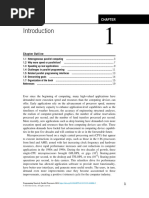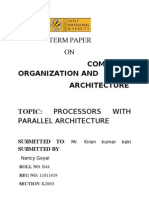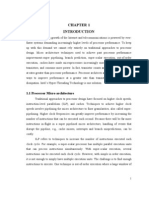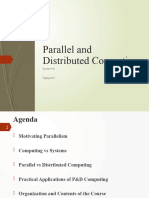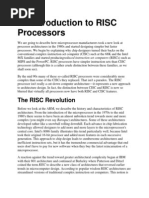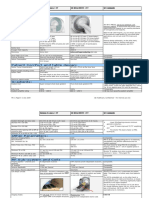Multicore Processor
Uploaded by
Krishnammal SenthilMulticore Processor
Uploaded by
Krishnammal SenthilGENERAL ARTICLE
Multi-core Microprocessors
V Rajaraman
Multi-core microprocessor is an interconnected set of inde-
pendent processors called cores integrated on a single sili-
con chip. These processing cores communicate and cooperate
with one another to execute one or more programs faster than
a single core processor. In this article we describe how and
why these types of processors evolved. We also describe the
basics of how multi-core microprocessors are programmed. V Rajaraman is at the Indian
Institute of Science,
Bengaluru. Several
Introduction generations of scientists and
engineers in India have learnt
Today every computer uses a multi-core microprocessor. This is computer science using his
not only true for desktop computers but also for laptops, tablets, lucidly written textbooks on
programming and computer
and even microprocessors used in smartphones. Each ‘core’ is
fundamentals. His current
an independent processor and in multi-core systems these cores research interests are parallel
work in parallel to speed up the processing. computing and history of
computing.
Reviewing the evolution of microprocessors, the first processor
that came integrated in a chip was the Intel 4004, a 4-bit micro-
processor that was introduced in 1971 and was primarily used in
pocket calculators. This was followed by the Intel 8008, an 8-
bit microprocessor introduced in 1972 that was used to build a
full-fledged computer. Based on empirical data, Gordon Moore
of Fairchild Semiconductors predicted that the number of transis-
tors which could be packed in an integrated circuit would double
almost every two years. This is often called Moore’s law and has
surprisingly been accurate till date (See Box 1). The increase in
the number of transistors in a microprocessor was facilitated by
decreasing the size of each transistor. Decreasing the size of tran-
sistors enabled faster clock speeds to be used to drive the circuits
using these transistors and resultant improvement in the process- Keywords
ing speed. Packing more transistors in a chip also enabled de- Moore’s law, evolution of multi-
core processors, programming
signers to improve the architecture of microprocessors in many
multi-core processors.
RESONANCE | December 2017 1175
GENERAL ARTICLE
The speed mismatch ways. The first improvement was increase in the chunks of data
between the processor that could be processed in each clock cycle. It was increased from
and the main memory in
8 bits to 64 bits by doubling the data path width every few years
a microcomputer was
reduced by increasing (See Table 1). Increasing the data path width also allowed a mi-
the number of registers croprocessor to directly address a larger main memory. Through-
in the processor and by out the history of computers, the processor was much faster than
introducing on-chip the main memory. Thus, reducing the speed mismatch between
cache memory.
the processor and the main memory in a microcomputer was the
next problem to be addressed. This was done by increasing the
number of registers in the processor and by introducing on-chip
cache memory using the larger number of transistors that could be
packed in a chip. Availability of a large number of transistors in a
chip also enabled architects to increase the number of arithmetic
units in a processor. Multiple arithmetic units allowed a proces-
sor to execute several instructions in one clock cycle. This is
called instruction level parallel processing. Another architectural
method of increasing the speed of processing besides increasing
the clock speed was by pipelining. In pipelining, the instruction
cycle of a processor is broken up into p steps, each taking ap-
proximately equal time to execute. The p steps of a set of se-
quential instructions are overlapped when a set of instructions are
executed sequentially (as in an assembly line) thereby increas-
ing the speed of execution of a large sequence of independent
instructions p fold. All these techniques, namely, increasing the
clock frequency, increasing the data path width, executing several
instructions in one clock cycle, increasing on-chip memory, and
pipelining that were used to increase the speed of a single proces-
sor in a chip could not be sustained as will be explained in what
follows.
Why Multi-core?
The number of We saw in the last section that the number of transistors packed
transistors packed in a
single silicon chip has in a single silicon chip has been doubling every two years with
been doubling every two the result that around 2006 designers were able to pack about 240
years. million transistors in a chip.
1176 RESONANCE | December 2017
GENERAL ARTICLE
Box 1. Moore’s Law
In 1965 Gordon Moore* who was working at Fairchild Semiconductors predicted, based on empirical data
available since integrated circuits were invented in 1958, that the number of transistors in an integrated
circuit chip would double every two years. This became a self-fulfilling prophecy in the sense that the
semiconductor industry took it as a challenge and as a benchmark to be achieved. A semiconductor
manufacturers’ association was formed comprising chip fabricators and all the suppliers who supplied
materials and components to the industry to cooperate and provide better components, purer materials,
and better fabrication techniques that enabled doubling the number of transistors in chips every two years.
Table 1 indicates how the number of transistors has increased in microprocessor chips made by Intel –
a major manufacturer of integrated circuits. In 1971, there were 2300 transistors in the microprocessors
made by Intel. By 2016, it had reached 7,200,000,000 – an increase by a factor about 3 × 106 in 23 years,
very close to Moore’s law’s prediction. The width of the gate in a transistor in the present technology
(called 14 nm technology) is about 50 times the diameter of a silicon atom. Any further increase in the
number of transistors fabricated in a planar chip will lead to the transistor gate size approaching 4 to 5
atoms. At this size quantum effects will be evident and a transistor may not work reliably. Thus we may
soon reach the end of Moore’s law as we know it now [1].
*Gordon E Moore, Cramming More Components, Electronics, Vol.38, No.8, pp.114–117, April 1965.
The question arose on how to effectively use these transistors in
designing microprocessors. One major point considered was that
most programs are written using a sequential programming lan-
guage such as C or C++. Many instructions in these languages
could be transformed by compilers to a set of instructions that
could be carried out in parallel. For example, in the instruction:
a = (b + c) − (d ∗ f ) − (g/h),
the add operation, the multiply operation, and the divide opera-
tion could be carried out simultaneously, i.e., in parallel. This
is called instruction-level parallelism. This parallelism could be
exploited provided there are three arithmetic units in the proces-
sor. Thus designers began putting many arithmetic units in pro-
cessors. However, the number of arithmetic units could not be In some programs, a set
increased beyond four as this simple type of parallelism does not of threads are
occur often enough in programs and that resulted in idle arith- independent of one
another and could be
metic units. Another parallelism is thread-level parallelism [2]. carried out concurrently
A thread in a program may be defined as a small set of sequential using multiple arithmetic
units.
RESONANCE | December 2017 1177
GENERAL ARTICLE
Year Intel Processor Data Path Number of Clock
Model Width Transistors Speed
1971 4004 4 2300 740 KHz
1972 8008 8 3500 500 KHz
1977 8085 8 6500 3 MHz
1978 8086 16 29,000 5 MHz
1982 80186 16 55,000 6 MHz
1982 80286 16 134,000 6 MHz
1985 80386 32 275,000 16–40 MHz
1989 80486 32 1,180,000 25 MHz
1993 Pentium 1 32 3,100,000 60–66 MHz
1995 Pentium Pro 32 5,500,000 150–200 MHz
1999 Pentium 3 32 9,500,000 450–660 MHz
2001 Itanium 1 64 25,000,000 733–800 MHz
2003 Pentium M 64 77,000,000 0.9–1.7 GHz
2006 Core 2 duo 64 291,000,000 1.8–2 GHz
2008 Core i7 Quad 64 730,000,000 2.66–3.2 GHz
2010 8 core Xeon 64 2,300,000,000 1.73-2.66 GHz
Nehalem – Ex
2016 22 core Xeon 64 7,200,000,000 2.2–3.6 GHz
Boradwell
Table 1. Timeline of
progress of Intel∗ proces- (*Intel processors are chosen as they are widely used and represent how a major
sors. manufacturer of microprocessors steadily increased the number of transistors in
their processor and the clock speed. The data given above is abstracted from the
articles on Intel microprocessor chronology and on transistor counts in micro-
processors published by Wikipedia. The numbers in the table are indicative as
there are numerous models of the same Intel microprocessor such as Pentium
3).
instructions that can be scheduled to be processed as a unit shar-
ing the same processor resources. A simple example of a thread
is a set of sequential instructions in a for loop. In some programs,
a set of threads are independent of one another and could be car-
ried out concurrently using multiple arithmetic units. In practice,
it is found that most programs have limited thread-level paral-
1178 RESONANCE | December 2017
GENERAL ARTICLE
lelism. Thus it is not cost effective to increase arithmetic units in
a processor beyond three or four to assist thread-level parallel pro-
cessing. Novel architectures such as very long instruction word
processors in which an instruction length was 128 to 256 bits and
packed several instructions that could be carried out in parallel
were also designed. But these had limited success as compilers
to exploit this architecture were difficult to write particularly be-
cause programs were most often written in languages such as C
that are inherently sequential and use pointers liberally. It was
found that designing a single processor with a complex structure
to exploit parallelism in sequential programs was becoming dif-
ficult. Designing complex processors is expensive and prone to
errors. Thus, the limit on instruction and thread-level processing
coupled with design complexity prompted designers to explore
additional methods of utilising the transistors available in a chip.
Another method of using transistors is to deploy them for fabri-
cating on-chip memory. Throughout the evolution of computer
architecture, memory speed was always slower than the speed of
processors. Besides this, main memories were external to the chip
and fetching data from an external memory to the processor us-
ing a bus was slow. Computers had to wait for instructions and
data to arrive at the CPU. This was alleviated by the invention of
caches, a small, fast memory that could be integrated as part of
a processor chip using the increasing number of transistors avail-
able in the chip. Separate caches for instructions and data are
now the norm. Designers thus started increasing the size of the
caches and on-chip memory to utilise the large number of avail-
able transistors to speed up processing. This also had diminishing
returns. It is effective to have a cache that can store a set of in- The limit on instruction
structions and data that would be immediately required by a pro- and thread-level
cessor (called a working set). Much larger cache than a working processing coupled with
design complexity
set is not very effective. Therefore, there is a limit beyond which prompted designers to
it is not cost-effective to increase the cache size. Designers were explore additional
forced to examine more alternatives to use the available transis- methods of utilising the
transistors available in a
tors. An obvious idea was to replicate processors (called ‘cores’),
chip.
place them on a single chip, and interconnect them to work co-
RESONANCE | December 2017 1179
GENERAL ARTICLE
Design cost of operatively to execute programs. This requires programming
multi-core processors is constructs that will assist in extracting parallelism in programs.
lower than the cost of
We will explain these constructs later in this article. Design cost
designing very complex
single processors. This is of multi-core processors is lower than the cost of designing very
because in a multi-core complex single processors. This is because in a multi-core pro-
processor a simple cessor a simple processor is designed and replicated.
processor is designed
and replicated. The idea of using several independent processors to work simul-
taneously and cooperate to execute a single program is quite old.
This was a very active area of research in the late 1970s and early
1980s [3, 5]. As the circuit interconnecting the processors was
outside the chip and slow in late 1970s, research challenges were
different. However, many of the ideas developed during this pe-
riod could be reused in designing multi-core processors.
Limits on Increasing Clock Frequency
As we saw, the speed of microprocessors was increased by both
architectural innovations and increasing the clock speed. Whereas
the number of transistors increased exponentially leading to ar-
chitectural innovations, the increase of clock speed was gradual
(See Table 1) and has remained constant around 3 GHz since
2006. This has been mainly due to heat dissipation in proces-
sors when the clock speed increased. There are three components
Whereas the number of of heat dissipation in processors when transistor switches toggle.
transistors increased They are:
exponentially leading to
architectural
innovations, the increase 1. The capacitance associated with a transistor switch charges and
of clock speed was discharges when it switches states. This causes power dissipation
gradual and has and consequently heating of the transistor. If C is the equivalent
remained constant capacitance of a transistor, Vd the voltage at which the transistor
around 3 GHz since
operates, and f the clock frequency, the power dissipation when
2006. This has been
mainly due to heat a transistor switches is proportional to CVd2 f . This is called dy-
dissipation in processors namic power dissipation. As f increases, the power dissipation
when the clock speed and consequently the heat dissipation increases.
increased.
2. A small current called leakage current Il flows continuously be-
tween different doped parts of a transistor. The leakage current
1180 RESONANCE | December 2017
GENERAL ARTICLE
increases when a transistor becomes smaller. The leakage cur-
rent causes a power dissipation proportional to Vd Il .
3. During the small but finite time when a transistor gate toggles,
a direct path exists between the voltage source and the ground.
This causes a short circuit current I st and leads to a power dis-
sipation proportional to Vd I st . This also increases as a transistor
becomes small.
The dynamic power
All the three components cause an increase in power dissipation
dissipation increases
when the size of transistors decreases. However, the dynamic rapidly as the clock
power dissipation increases rapidly as the clock frequency in- frequency increases
creases. This causes an inordinate increase in the temperature of causing an inordinate
increase in the
transistors in a chip as it heats up. When the frequency becomes
temperature of
4 GHz, the heat generated will cause the transistors in the chip transistors in a chip as it
to almost melt unless the chip is cooled by special cooling tech- heats up.
niques such as chilled water piping on which the chip is mounted.
This is impractical for processors used in laptop computers. Thus,
the only practical means of using the increasing number of tran-
sistors in a chip to increase the speed of execution of programs
by microprocessors is to pack many processing cores inside one
chip and make them work cooperatively to execute programs. As
the same processor core is replicated in a chip, the design cost of
chips could be controlled. This led to the emergence of multi-core
microprocessors.
Structure of Multi-core Microprocessors
A simple definition of a multi-core microprocessor is [3]:
“It is an interconnected set of independent processing cores in-
tegrated on a single silicon chip. These processing cores com-
municate and cooperate with one another to execute one or more
programs”.
The key points in the above definition are:
1. Set of independent processors called processing cores are inte-
grated in a single silicon chip.
RESONANCE | December 2017 1181
GENERAL ARTICLE
Figure 1. Structure of a
multicore microprocessor.
2. The cores are interconnected and communicate with one an-
other.
3. The processing cores cooperate to execute programs.
A block diagram of a general multi-core microprocessor is given
in Figure 1.
A variety of multi-core microprocessors may be fabricated as the
three crucial features of multi-core chips may be varied as listed
below [3]:
Types of Processor Cores
1. A simple single threaded processor.
2. A multi-threaded complex processor.
3. A processor that is just an arithmetic logic unit with a multiplier
and an accumulator (MAC unit).
1182 RESONANCE | December 2017
GENERAL ARTICLE
4. A hybrid system combining simple and complex processors.
Number of Processing Cores
1. A small number of identical cores < 16.
2. A medium number of cores (of the order of hundreds).
3. A very large number (thousands) of multiply accumulate (MAC)
units.
Interconnection of processor cores
1. The cores may be interconnected using a bus.
2. The cores may be interconnected by a ring, a crossbar switch, or
they may form a grid.
Mode of Cooperation
When each processing
core is assigned separate
programs, all the cores
1. Each processing core may be assigned separate programs. All
executing the programs
the cores execute the programs assigned to them independently assigned to them
and concurrently. This mode of cooperation is called Request- independently and
Level Parallel Processing. concurrently, it is called
Request-Level Parallel
2. All processing cores execute the same program concurrently but Processing.
on different data sets. This is called Single Program Multiple
Data mode of parallel processing (called SPMD).
3. All processing cores execute a single instruction on multiple data
streams or threads. This is called Single Instruction Multiple
Data or Thread Computing (SIMD) or (SIMT).
4. A single program is split into a number of threads of instructions
and stored in a shared memory. The threads are scheduled on
different processors in such a way that all the processing cores
cooperate to execute the program in minimum time by keeping
all the cores concurrently processing threads. This is called Mul-
tiple Instruction Multiple Data Stream (MIMD) parallel process-
ing. In this model, synchronising the execution of threads which
RESONANCE | December 2017 1183
GENERAL ARTICLE
execute concurrently in different cores is essential and requires
clever programming.
Examining the description given above, it is clear that a large vari-
ety of multi-core microprocessors could be built. Normally when
the number of cores is below 16, the cores are interconnected by
a bus which is the simplest method of interconnecting proces-
sors. Beyond around 16 cores contention for using the common
bus causes reduction of the speed of multi-core processors. Thus
other types of interconnections are used. When there are large
number of processors (exceeding 16) and an interconnection sys-
tem other than a bus are used, they are classified as many-core
processors. This definition is somewhat arbitrary. We, however,
will use this definition in this article. In many core processors, the
cores are interconnected by networks such as grid, ring, etc., and
the programming method uses message passing between cores to
cooperatively solve problems.
When the number of cores is of the order of thousands, then the
cores are simple Multiply Accumulate Units (MAC units). These
type of multi-core processors are useful for image processing in
Normally when the which a huge number of pixels can be independently processed
number of cores is below by the cores and in calculations that require arithmetic operations
16, the cores are
using very large matrices. Such processors are called General
interconnected by a bus
which is the simplest Purpose Graphics Processing Units (GPGPUs). They are quite
method of often used as co-processors in supercomputers.
interconnecting
processors. In this article, we will describe only multi-core microprocessors
and not many-core microprocessors or GPGPUs
Design Consideration of Multi-core Microprocessor
While designing multi-core microprocessors it is necessary to
consider the following:
1. Applications of the microprocessor.
1184 RESONANCE | December 2017
GENERAL ARTICLE
2. The power dissipated by the system. It should not exceed 300
watts (a rule of thumb) if the microprocessor is to be air-cooled.
3. Spreading the heat dissipation evenly without creating hot spots The cost of designing
in chips. multi-core processors is
reduced if a single
4. On-chip interconnection network should normally be planar as module, namely, the
the interconnection wires are placed in a layer on top of the pro- core, cache, and bus
cessor layer. In multi-core microprocessors, a bus is used to in- interconnection is
replicated as the
terconnect the processors.
maximum design effort
5. The cost of designing multi-core processors is reduced if a sin- is required in designing a
core and its cache and in
gle module, namely, the core, cache, and bus interconnection is
verifying the design.
replicated as the maximum design effort is required in designing
a core and its cache and in verifying the design.
6. All multi-core microprocessors use an interconnection bus and
share the main memory. The programming model used is what
is known as a shared memory programming in which a program
to be executed is stored in the memory shared by all the cores.
When a shared memory program is used, the instruction set of a
processing core should have instructions to fork from a process,
lock a process, unlock a process and join a process after forking.
These instructions are essential to write parallel programs.
Bus Connected Multi-core Microprocessors
We depict in Figure 2 a typical bus connected multi-core proces-
sor with n cores. In 2001 IBM Power4 was the first dual-core The speed of a
processor to be released. The number of cores has doubled every multi-core
microprocessor increases
few years. The speed of a multi-core microprocessor increases
almost linearly as the
almost linearly as the number of cores increases as long as the number of cores
cores do not have to communicate with one another. There are increases as long as the
many problems where the cores can work independently without cores do not have to
having to communicate with one another. We will describe such communicate with one
another. There are many
problems in a later section. However, many problems require the problems where the
cores to communicate with one another and cooperate to solve a cores can work
problem. In such cases the interconnection bus becomes a bottle- independently without
neck as it is to be shared by all the cores. This limits the number having to communicate
with one another.
of cores to about 16. Observe that each core in Figure 2 has its
RESONANCE | December 2017 1185
GENERAL ARTICLE
Figure 2. A bus connector
multi-core microprocessor.
Temperature sensors are own cache called an L1 cache. The L1 cache is divided into
used to switch off a core 2 parts – a data cache to store data that will be immediately re-
when it gets heated and quired by the core and an instruction cache where a segment of
distribute its load to
other cores. a program needed immediately by the processing core is stored.
The data and instruction cache sizes vary between 16 and 64 KB.
Another interesting part of a core is the temperature sensor. Tem-
perature sensors are not normally used in single core systems.
In multi-core systems, they are used particularly if the cores are
complex processors such as Intel’s i7 (a multi-threaded super-
scalar processor). Such processors tend to heat up at high fre-
quencies (3 GHz). If a core heats up its neighbouring cores may
also get affected and the chip may fail. Temperature sensors are
used to switch off a core when it gets heated and distribute its
load to other cores. In Figure 2 we have shown an L2 cache as
Microprocessors use an a shared on-chip memory. This is feasible as the huge number
on-chip cache to place in of transistors available on a chip now may be used to fabricate
it data and instructions L2 cache. Memory does not get heated unlike processors as they
immediately needed for
computation. switch only when data is written or read from them. The memory
outside the chip is divided into a static RAM used as an L3 cache
1186 RESONANCE | December 2017
GENERAL ARTICLE
and a larger dynamic RAM main memory. Some recent chips
integrate L3 cache also inside the chip.
Cache Coherence Problem
Microprocessors use an on-chip cache to place in it data and in-
structions immediately needed for computation. This is because
reading from and writing data in a cache is over hundred times
faster than reading/writing data from/to memory outside a chip. It
is not always easy to predict what data/instructions will be needed
during the course of execution of a program. Normally programs
are sequential and systems have evolved to make good predic-
tions of what data would be needed and are to be kept in the
cache. However, the prediction is not always correct and often
the data needed by a program running in a processor is not in the
cache. This is called a cache-miss. If there is a cache-miss, the
required data has to be fetched from the off-chip memory which
would slow down the execution of programs.
The situation in a shared memory multi-core processor is more
complicated as each core has its own cache. When a core writes
data in its cache other cores will not know this unless they are
informed. Thus, another core that is working concurrently may
read old data written earlier and not the latest data written by an-
other core. In other words, all caches may not have the same
value for a given variable, that is, all the caches may not be in
a coherent state. The hardware has to ensure cache coherence to
get correct results when a program is executed. Cache-coherence When a multi-core
protocols have been designed and implemented in the cache con- microprocessor is used
troller hardware of multi-core microprocessors to ensure cache as the main processor,
normally they use a
coherence and correct execution of parallel programs. There are multi-tasking operating
many protocols each with its own advantages and disadvantages. system that allows the
Discussion of these protocols is outside the scope of this article execution of many tasks
and readers may refer to [3] in the suggested reading list to learn concurrently.
about them.
RESONANCE | December 2017 1187
GENERAL ARTICLE
Programming Multi-core Microprocessor
There are three models of programming multi-core microproces-
sors. They are:
1. Request Level Parallel Programming
When a multi-core microprocessor is used as the main proces-
sor of a tablet, laptop, or desktop computer normally they use a
multi-tasking operating system that allows executing many tasks
concurrently. For example, a user may be using a word processor
while listening to an Internet radio station and concurrently scan-
ning a file for viruses. Each of these tasks may be assigned to a
different core in a multi-core system. There will be hardly any
interaction among these different tasks allowing all the cores to
cater to requests for processing concurrently and independently
tasks assigned to them. This style of parallel programming is
called Request Level Parallel Programming. A four-core proces-
sor will be almost four times faster than a single-core processor
assuming that the same core is replicated.
2. Single Program Multiple Data Parallel Programming
Many problems lead themselves to this mode of processing. For
example, if a frequency chart of distribution by the age of a large
population of 10 million persons is to be plotted, then data per-
taining to 2.5 million persons may be assigned to each core of
a four-core system. These four cores can concurrently execute
identical programs to plot the frequency distribution by age for
the population assigned to them. These results can then be merged.
This style of parallel programming is called Single Program Mul-
tiple Data programming (SPMD). There are many problems in
which a data set of n data items can be partitioned into k chunks
each with (n/k) data items where k is the number of cores. Each
data set may be assigned to a core that can work independently.
Thus, we get almost k fold increase in speed of processing com-
pared to a single core processor. Some examples where SPMD
style of programming is effective are: Monte Carlo simulation,
1188 RESONANCE | December 2017
GENERAL ARTICLE
statistical calculations on large populations, protein folding, and Two statements – fork
image processing. In such problems, multi-core computers are and join – are added to a
programming language
very efficient as cores process tasks independently and rarely com-
to enable the creation of
municate. Such problems are often called embarrassingly paral- processes and for
lel. waiting for them to
2. Multiple Instruction Multiple Data Programming
complete and re-join the
main program.
In a shared memory multi-core processor in which a program
stored in a shared memory is to be executed by the cores co-
operatively, the program is viewed as a collection of processes.
Each core is assigned a different process to be executed with the
required data that is stored in the shared memory. The cores ex-
ecute processes assigned to them independently. When all the
cores complete the task assigned to them, they re-join to com-
plete execution of the program. Two statements are added to a
programming language to enable the creation of processes and
for waiting for them to complete and re-join the main program.
These statements are fork to create a process and join when the
invoking process needs the results from the invoked process to
continue processing. For example, consider the following state-
ments of a parallel program in which P1 and P2 are two processes
to be executed in parallel [3]:
Core x Core y
begin P1 begin P1
.. ..
. .
fork P2;
.. ..
. .
join P2;
.. ..
. .
end P2 end P2
In the above program a process P1 is being executed in Core x.
When it encounters the statement fork P2 it invoked a process P2
in another Core y. The processes in Core x and Core y execute
concurrently. When the process P1 encounters join P2 statement,
it examines whether the process P2 running in Core y has ter-
RESONANCE | December 2017 1189
GENERAL ARTICLE
When multiple processes minated. If yes P1 takes the result from Core y and continues
work concurrently in processing. Core y is free to be assigned another process. If no
different cores and
then Core x waits until Core y completes P2 to get the results in
update data stored in the
shared memory, it is order to continue processing.
necessary to ensure that
When multiple processes work concurrently in different cores and
a shared variable value is
not initialised or updated update data stored in the shared memory, it is necessary to ensure
independently and that a shared variable value is not initialised or updated indepen-
simultaneously by these dently and simultaneously by these processes. We illustrate this
processes. by a parallel program to compute sum ← sum + f (A) + f (B).
Suppose we write the following parallel program:
Core x Core y
begin P1 begin P2
.. ..
. .
fork P2; sum ← sum + f (B);
.. ..
. .
sum ← sum + f (A); end P2
..
.
join P2;
..
.
end P1
Suppose process P1 loads sum in its register to add f (A) to it. If
process P2 also loads sum in its local register to add f (B). Process
P1 will be having sum + f (A) in its local register, and P2 will
have sum + f (B) in its local register. If both store the result back
in the shared memory the memory will have either sum + f (A)
or sum + f (B) depending on which process stored the result first.
The result expected is however sum+ f (A)+ f (B). We have to thus
ensure that the two processes store sum in the main memory in a
sequential order. To ensure this parallel programming languages
add a statement lock < variablename >. If a process locks a
variable name no other process can access this variable until it is
unlocked by the process that locked it. This ensures that only one
process can update a shared variable name at a time. The program
1190 RESONANCE | December 2017
GENERAL ARTICLE
to compute sum + f (A) + f (B) is written below using the lock and
unlock statements.
Core x Core y
begin P1 begin P2
.. ..
. .
fork P2; lock sum;
..
. sum ← sum + f (B);
lock sum; unlock sum;
..
sum ← sum + f (A); .
unlock sum; end P2
..
.
join P2;
..
.
end P1
In the above program, the process that reaches lock sum first will
update it. Until it is unlocked sum cannot be accessed by any
other process using proper locking mechanism. After it is un-
locked the other process can update it. This serialises the opera-
tion on a shared variable. As was pointed out earlier in this ar-
ticle the machine instructions of cores to be used in a multi-core
microprocessor normally incorporate fork, join, lock and unlock
instructions.
An important requirement to correctly execute multiple processes
concurrently is known as sequential consistency [3]. It is defined
as:
“A multiprocessor is sequentially consistent if the result of any The machine instructions
execution is the same as if the operation of all the processors were of cores to be used in a
executed in some sequential order and the operations of each in- multi-core
microprocessor normally
dividual processor occur in this sequence in the order specified by incorporate in addition
its program”. to fork, hand, join, lock
and unlock instructions.
In order to ensure this in hardware, each processor must appear to
issue and complete memory operations one at a time in program
RESONANCE | December 2017 1191
GENERAL ARTICLE
A multiprocessor is order. Hardware protocol used to ensure cache coherence will
sequentially consistent if ensure sequential consistency [3].
the result of any
execution is the same as
if the operation of all the Conclusions
processors were
executed in some Multi-core microprocessors have now become the main stream.
sequential order and the
operations of each
Their major advantages are that they work faster on many appli-
individual processor cations. As clock speed is below 4 GHz, they do not become too
occur in this sequence in hot. It is possible to switch a job from a core that is hot to an-
the order specified by its other relatively cool core to prevent failure of the microprocessor.
program.
Operating Systems now support parallel execution of programs
in multi-core microprocessors. Design cost of multi-core proces-
sors can be kept under control as identical cores are replicated on
a chip. The major disadvantage of multi-core computers is the
difficulty in programming general problems. Scheduling tasks to
optimize the utilisation of all cores is not easy. Request level pro-
gramming tasks and tasks that can be solved using SPMD mode
of programming are easy to schedule using all the cores and are
most often used.
Acknowledgment
I thank Dr. S Balakrishnan, Prof. C Siva Ram Murthy, and Dr. S
Ramani for reviewing this article and their constructive comments
that helped me to improve this article.
Address for Correspondence
V Rajaraman
Suggested Reading
Honorary Professor
Super Computer Education & [1] M Mitchell Waldrop, The Chips are Down for Moore’s Law, Nature, Vol.530,
Research Centre 11 Feb, pp.144–147, 2016.
Indian Institute of Science [2] Vankat Arun, Multithreaded Processors, Resonance, Vol.20, No.9, pp.344–55,
Bengaluru 560 012 2015.
Email: [3] V Rajaraman, and C Siva Ram Murthy, Parallel Computer Architecture and
rajaram@serc.iisc.in Programming, 2nd edition, PHI Learning, Delhi, July 2016.
[4] G Blake, R G Dreslinski and T Mudge, A Survey of Multicore Processors,
IEEE Signal Processing, Vol.26, No.6, pp.26–37, Nov.2009.
[5] P J Denning and J B Dennis, Resurgence of Parallelism, Communications of
ACM, Vol.53, No.6, pp.30–32, August 2010.
1192 RESONANCE | December 2017
You might also like
- Hourglass Workout Program by Luisagiuliet 276% (21)Hourglass Workout Program by Luisagiuliet 251 pages
- The Hold Me Tight Workbook - Dr. Sue Johnson100% (16)The Hold Me Tight Workbook - Dr. Sue Johnson187 pages
- Read People Like A Book by Patrick King-Edited62% (66)Read People Like A Book by Patrick King-Edited12 pages
- Livingood, Blake - Livingood Daily Your 21-Day Guide To Experience Real Health77% (13)Livingood, Blake - Livingood Daily Your 21-Day Guide To Experience Real Health260 pages
- COSMIC CONSCIOUSNESS OF HUMANITY - PROBLEMS OF NEW COSMOGONY (V.P.Kaznacheev,. Л. V. Trofimov.)94% (212)COSMIC CONSCIOUSNESS OF HUMANITY - PROBLEMS OF NEW COSMOGONY (V.P.Kaznacheev,. Л. V. Trofimov.)212 pages
- Donald Trump & Jeffrey Epstein Rape Lawsuit and Affidavits83% (1016)Donald Trump & Jeffrey Epstein Rape Lawsuit and Affidavits13 pages
- The 36 Questions That Lead To Love - The New York Times94% (34)The 36 Questions That Lead To Love - The New York Times3 pages
- The 36 Questions That Lead To Love - The New York Times95% (21)The 36 Questions That Lead To Love - The New York Times3 pages
- Jeffrey Epstein39s Little Black Book Unredacted PDF75% (12)Jeffrey Epstein39s Little Black Book Unredacted PDF95 pages
- The 4 Hour Workweek, Expanded and Updated by Timothy Ferriss - Excerpt23% (954)The 4 Hour Workweek, Expanded and Updated by Timothy Ferriss - Excerpt38 pages
- Win-Pak 4.9.4 Specifications and RequirementsNo ratings yetWin-Pak 4.9.4 Specifications and Requirements4 pages
- Flexran Reference Solution NB Iot User GuideNo ratings yetFlexran Reference Solution NB Iot User Guide55 pages
- Ece 10 - Microprocessor and Microcontroller System and Design (Module 1)No ratings yetEce 10 - Microprocessor and Microcontroller System and Design (Module 1)20 pages
- Chapter-1---Introduction_2023_Programming-Massively-Parallel-ProcessorsNo ratings yetChapter-1---Introduction_2023_Programming-Massively-Parallel-Processors20 pages
- Performance Analysis On Multicore ProcessorsNo ratings yetPerformance Analysis On Multicore Processors9 pages
- Ch.2 Performance Issues: Computer Organization and ArchitectureNo ratings yetCh.2 Performance Issues: Computer Organization and Architecture25 pages
- Week 6 - Review On High Performance Energy Efficient Multicore Embedded Computing 1No ratings yetWeek 6 - Review On High Performance Energy Efficient Multicore Embedded Computing 17 pages
- Quad-Core Microprocessor Specific Architectures: Coordinating Teacher - Radescu RaduNo ratings yetQuad-Core Microprocessor Specific Architectures: Coordinating Teacher - Radescu Radu23 pages
- Hyper-Threading Technology: Processor MicroarchitectureNo ratings yetHyper-Threading Technology: Processor Microarchitecture18 pages
- Unit I-Basic Structure of A Computer: SystemNo ratings yetUnit I-Basic Structure of A Computer: System64 pages
- Processors: by Nipun Sharma ID: 1411981520No ratings yetProcessors: by Nipun Sharma ID: 141198152024 pages
- Hyper Threading Technology in MicroprocessorsNo ratings yetHyper Threading Technology in Microprocessors3 pages
- Multi-Core Processor: From Wikipedia, The Free EncyclopediaNo ratings yetMulti-Core Processor: From Wikipedia, The Free Encyclopedia10 pages
- Hyper-Threading Technology: Shaik Mastanvali (06951A0541)No ratings yetHyper-Threading Technology: Shaik Mastanvali (06951A0541)23 pages
- COS 464 Concurrent Progr by DR Mrs AsogwaNo ratings yetCOS 464 Concurrent Progr by DR Mrs Asogwa16 pages
- Design and Implementation of Convolutional Neural Network Accelerator Based On RISCVNo ratings yetDesign and Implementation of Convolutional Neural Network Accelerator Based On RISCV6 pages
- Riding The Next Wave of Embedded Multicore Processors: - Maximizing CPU Performance in A Power-Constrained WorldNo ratings yetRiding The Next Wave of Embedded Multicore Processors: - Maximizing CPU Performance in A Power-Constrained World36 pages
- Technical Writing #1: Development of Wireless Communication Algorithm For Multicore ArchitectureNo ratings yetTechnical Writing #1: Development of Wireless Communication Algorithm For Multicore Architecture1 page
- Multicore Processor Technology-Advantages and Challenges: Anil Sethi, Himanshu KushwahNo ratings yetMulticore Processor Technology-Advantages and Challenges: Anil Sethi, Himanshu Kushwah3 pages
- 1.1. Computers & Processors:: Chapter-1No ratings yet1.1. Computers & Processors:: Chapter-132 pages
- Thread Level Parallelism and Interactive PerformanNo ratings yetThread Level Parallelism and Interactive Performan11 pages
- Digital Electronics, Computer Architecture and Microprocessor Design PrinciplesFrom EverandDigital Electronics, Computer Architecture and Microprocessor Design PrinciplesNo ratings yet
- System Requirements For Cs Softdent Practice Management Software, V17No ratings yetSystem Requirements For Cs Softdent Practice Management Software, V174 pages
- UCS E Series Overview Part 1 ISR and UCS E IntroductionNo ratings yetUCS E Series Overview Part 1 ISR and UCS E Introduction25 pages
- BladeSymphony 2000 Datasheet G10 (Press Quality)No ratings yetBladeSymphony 2000 Datasheet G10 (Press Quality)5 pages
- IVMS-5200 ANPR V1.0.2 Software Requirements & Hardware PerformanceNo ratings yetIVMS-5200 ANPR V1.0.2 Software Requirements & Hardware Performance11 pages
- Performance Guide: Microsoft Dynamics NAV 2009100% (2)Performance Guide: Microsoft Dynamics NAV 200940 pages
- Intel Xeon Processor E5-1400/2400 Product FamilyNo ratings yetIntel Xeon Processor E5-1400/2400 Product Family47 pages
- Pymic: A Python Offload Module For The Intel Xeon Phi™ CoprocessorNo ratings yetPymic: A Python Offload Module For The Intel Xeon Phi™ Coprocessor21 pages
- Solution For Databases For Oracle Rac With VSP 5500 Advanced Server ds220 Using Intel Cascade Lake CpusNo ratings yetSolution For Databases For Oracle Rac With VSP 5500 Advanced Server ds220 Using Intel Cascade Lake Cpus30 pages
- External Design Specification (EDS) Addendum: May 2016 Revision 001No ratings yetExternal Design Specification (EDS) Addendum: May 2016 Revision 00122 pages
- International Journal of Distributed and Parallel Systems (IJDPS)No ratings yetInternational Journal of Distributed and Parallel Systems (IJDPS)20 pages
- HP Zbook 15 G3 Mobile Workstation: Maintenance and Service GuideNo ratings yetHP Zbook 15 G3 Mobile Workstation: Maintenance and Service Guide207 pages
- Poweredge T40: The Dependable Building Block For Your Small BusinessNo ratings yetPoweredge T40: The Dependable Building Block For Your Small Business2 pages
- Livingood, Blake - Livingood Daily Your 21-Day Guide To Experience Real HealthLivingood, Blake - Livingood Daily Your 21-Day Guide To Experience Real Health
- COSMIC CONSCIOUSNESS OF HUMANITY - PROBLEMS OF NEW COSMOGONY (V.P.Kaznacheev,. Л. V. Trofimov.)COSMIC CONSCIOUSNESS OF HUMANITY - PROBLEMS OF NEW COSMOGONY (V.P.Kaznacheev,. Л. V. Trofimov.)
- Donald Trump & Jeffrey Epstein Rape Lawsuit and AffidavitsDonald Trump & Jeffrey Epstein Rape Lawsuit and Affidavits
- The 36 Questions That Lead To Love - The New York TimesThe 36 Questions That Lead To Love - The New York Times
- The 36 Questions That Lead To Love - The New York TimesThe 36 Questions That Lead To Love - The New York Times
- Jeffrey Epstein39s Little Black Book Unredacted PDFJeffrey Epstein39s Little Black Book Unredacted PDF
- The 4 Hour Workweek, Expanded and Updated by Timothy Ferriss - ExcerptThe 4 Hour Workweek, Expanded and Updated by Timothy Ferriss - Excerpt
- Ece 10 - Microprocessor and Microcontroller System and Design (Module 1)Ece 10 - Microprocessor and Microcontroller System and Design (Module 1)
- Chapter-1---Introduction_2023_Programming-Massively-Parallel-ProcessorsChapter-1---Introduction_2023_Programming-Massively-Parallel-Processors
- Ch.2 Performance Issues: Computer Organization and ArchitectureCh.2 Performance Issues: Computer Organization and Architecture
- Week 6 - Review On High Performance Energy Efficient Multicore Embedded Computing 1Week 6 - Review On High Performance Energy Efficient Multicore Embedded Computing 1
- Quad-Core Microprocessor Specific Architectures: Coordinating Teacher - Radescu RaduQuad-Core Microprocessor Specific Architectures: Coordinating Teacher - Radescu Radu
- Hyper-Threading Technology: Processor MicroarchitectureHyper-Threading Technology: Processor Microarchitecture
- Multi-Core Processor: From Wikipedia, The Free EncyclopediaMulti-Core Processor: From Wikipedia, The Free Encyclopedia
- Hyper-Threading Technology: Shaik Mastanvali (06951A0541)Hyper-Threading Technology: Shaik Mastanvali (06951A0541)
- Design and Implementation of Convolutional Neural Network Accelerator Based On RISCVDesign and Implementation of Convolutional Neural Network Accelerator Based On RISCV
- Riding The Next Wave of Embedded Multicore Processors: - Maximizing CPU Performance in A Power-Constrained WorldRiding The Next Wave of Embedded Multicore Processors: - Maximizing CPU Performance in A Power-Constrained World
- Technical Writing #1: Development of Wireless Communication Algorithm For Multicore ArchitectureTechnical Writing #1: Development of Wireless Communication Algorithm For Multicore Architecture
- Multicore Processor Technology-Advantages and Challenges: Anil Sethi, Himanshu KushwahMulticore Processor Technology-Advantages and Challenges: Anil Sethi, Himanshu Kushwah
- Thread Level Parallelism and Interactive PerformanThread Level Parallelism and Interactive Performan
- Digital Electronics, Computer Architecture and Microprocessor Design PrinciplesFrom EverandDigital Electronics, Computer Architecture and Microprocessor Design Principles
- System Requirements For Cs Softdent Practice Management Software, V17System Requirements For Cs Softdent Practice Management Software, V17
- UCS E Series Overview Part 1 ISR and UCS E IntroductionUCS E Series Overview Part 1 ISR and UCS E Introduction
- IVMS-5200 ANPR V1.0.2 Software Requirements & Hardware PerformanceIVMS-5200 ANPR V1.0.2 Software Requirements & Hardware Performance
- Pymic: A Python Offload Module For The Intel Xeon Phi™ CoprocessorPymic: A Python Offload Module For The Intel Xeon Phi™ Coprocessor
- Solution For Databases For Oracle Rac With VSP 5500 Advanced Server ds220 Using Intel Cascade Lake CpusSolution For Databases For Oracle Rac With VSP 5500 Advanced Server ds220 Using Intel Cascade Lake Cpus
- External Design Specification (EDS) Addendum: May 2016 Revision 001External Design Specification (EDS) Addendum: May 2016 Revision 001
- International Journal of Distributed and Parallel Systems (IJDPS)International Journal of Distributed and Parallel Systems (IJDPS)
- HP Zbook 15 G3 Mobile Workstation: Maintenance and Service GuideHP Zbook 15 G3 Mobile Workstation: Maintenance and Service Guide
- Poweredge T40: The Dependable Building Block For Your Small BusinessPoweredge T40: The Dependable Building Block For Your Small Business




































